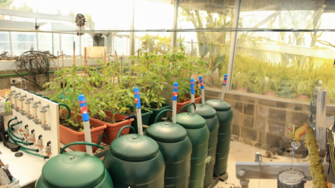
- UNSW
- ...
- UNESCO Centre for Membrane Science and Technology
- Our research
- Food & agriculture
- Membrane facilitated subsurface drip irrigation
- Home
- About us
-
Our research
- Membrane material development
-
Water treatment
- Study of floc strength and stability during direct filtration of surface water
- Mass and heat transfer in submerged vacuum membrane distillation and crystallization
- Development of novel membrane integrity tests for virus sized particles
- Reuse of old reverse osmosis membranes used in desalination plants | UNESCO Centre for Membrane Science and Technology - UNSW Sydney
- Optimisation of hybrid coagulation/submerged membrane bioreactor treatment of wastewaters | UNESCO Centre for Membrane Science and Technology - UNSW Sydney
- Developing national validation guidelines for MBRs in water recycling
- Assisted forward osmosis for energy savings in RO desalination
- Characterising nanostructure functionality of conventional and advanced polymeric membranes using electrical impedance spectroscopy
- Optimising low-pressure membrane pre-treatment for desalination | UNESCO Centre for Membrane Science and Technology - UNSW Sydney
-
Process design & modelling
- Computational fluid dynamics modelling of Membrane Bioreactors
- Resilience modelling of advanced water treatment plants
- Mechanical reliability of microporous membranes in water recycling applications
- Optimisation of Membrane Distillation Processes
- Feedback Destabilizing Control of Electro-osmotic Flow
- Greenhouse gas technology
- Bio-separations
-
Food & agriculture
- Membrane facilitated subsurface drip irrigation
- Milk ultrafiltration
- Protein recovery from potato processing water using ultrafiltration membrane
- Phosphorus recovery from wastewater
- Sequential chemical and enzymatic cleaning of ultrafiltration membranes in dairy applications
- Application of membrane separation process in concentration and separation of polyphenol compounds for evaluation of their health benefits
- Optimising low-pressure membrane pre-treatment for desalination
-
Archived research projects
- Composite biocatalytic nanoflower
- Superhydrophobic Membranes for Membrane Distillation Applications
- Polymers for Isoporous and Functional Membranes
- Separation performance of dip-coated microporous hollow fibre polymer inclusion membranes (PIM)
- Improvement in Fouling Release Properties of Ultrafiltation PVDF Membranes
- Thin Film Nano-composite Membrane Fabrication for Carbon Dioxide Capture from Flue Gas
- MOF based highly efficient gas separation membrane
- Biocatalytic membrane reactors for greenhouse gas capture
- Evaluation of CO2 Capture with High Performance Hollow Fiber Membranes from Flue Gas: A Pilot Scale Study
- Improved Carbon Dioxide Separation Performance with Additives of PEO/PDMS Copolymer in PPO Membranes
- Our facilities
- Our services
- Contact us
- Home
- About us
-
Our research
Water treatment
- Study of floc strength and stability during direct filtration of surface water
- Mass and heat transfer in submerged vacuum membrane distillation and crystallization
- Development of novel membrane integrity tests for virus sized particles
- Reuse of old reverse osmosis membranes used in desalination plants | UNESCO Centre for Membrane Science and Technology - UNSW Sydney
- Optimisation of hybrid coagulation/submerged membrane bioreactor treatment of wastewaters | UNESCO Centre for Membrane Science and Technology - UNSW Sydney
- Developing national validation guidelines for MBRs in water recycling
- Assisted forward osmosis for energy savings in RO desalination
- Characterising nanostructure functionality of conventional and advanced polymeric membranes using electrical impedance spectroscopy
- Optimising low-pressure membrane pre-treatment for desalination | UNESCO Centre for Membrane Science and Technology - UNSW Sydney
Process design & modelling
- Computational fluid dynamics modelling of Membrane Bioreactors
- Resilience modelling of advanced water treatment plants
- Mechanical reliability of microporous membranes in water recycling applications
- Optimisation of Membrane Distillation Processes
- Feedback Destabilizing Control of Electro-osmotic Flow
Food & agriculture
- Membrane facilitated subsurface drip irrigation
- Milk ultrafiltration
- Protein recovery from potato processing water using ultrafiltration membrane
- Phosphorus recovery from wastewater
- Sequential chemical and enzymatic cleaning of ultrafiltration membranes in dairy applications
- Application of membrane separation process in concentration and separation of polyphenol compounds for evaluation of their health benefits
- Optimising low-pressure membrane pre-treatment for desalination
Archived research projects
- Composite biocatalytic nanoflower
- Superhydrophobic Membranes for Membrane Distillation Applications
- Polymers for Isoporous and Functional Membranes
- Separation performance of dip-coated microporous hollow fibre polymer inclusion membranes (PIM)
- Improvement in Fouling Release Properties of Ultrafiltation PVDF Membranes
- Thin Film Nano-composite Membrane Fabrication for Carbon Dioxide Capture from Flue Gas
- MOF based highly efficient gas separation membrane
- Biocatalytic membrane reactors for greenhouse gas capture
- Evaluation of CO2 Capture with High Performance Hollow Fiber Membranes from Flue Gas: A Pilot Scale Study
- Improved Carbon Dioxide Separation Performance with Additives of PEO/PDMS Copolymer in PPO Membranes
- Our facilities
- Our services
- Contact us

Centre researchers demonstrated that a subsurface drip irrigation line manufactured from a commercially available reverse osmosis membrane was capable of providing sufficient water for the cultivation of tomato plants on brackish water while preventing the accumulation of salts in the soil. These preliminary experiments demonstrated that brackish and saline groundwater that would normally be unsuitable for use in irrigation systems for the cultivation of food crops can be used to grow plants, such as tomatoes without allowing the build up of salts in the soil. In these experiments, the plants grew by creating suction in the root zone (sub-surface) which provided sufficient force to draw water across the reverse osmosis membrane, however, the RO membrane prevented the transport of salts which can damage the soil.
The membrane technology, developed by Professor Leslie and the University of Sydney’s Professor Bruce Sutton, has been patented by UNSW commercial arm, NewSouth Innovations and commercialization partners are being sought.
- Research team
- Patents


Bruce Sutton

Valeria Almeida Lima
Leslie, G. L. and Sutton, B. G, Reverse Osmosis Irrigation WO 2009/105808;
Leslie, G. L., Sutton, B. G and Antony, A. A Plant Watering Device PCT 2012/85574
